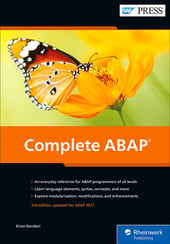The source code of an ABAP program is made up of various ABAP statements.
Unlike other programming languages, such as C/C++ or Java, which contain a limited set of language-specific statements and provide most functionality via libraries, ABAP contains an extensive set of built-in statements.
The best way to learn about the various ABAP statements available is to put them in perspective with the requirements at hand. It’s beyond the scope of this post to cover all the available ABAP statements, so we’ll briefly introduce some popular statements here:
- Declarative statements: Declarative statements define data types or declare data objects that are used by the other statements in a program. Examples include the following: TYPE, DATA, CONSTANTS, PARAMETERS, SELECT-OPTIONS, and TABLES.
- Modularization statements: Modularization statements define the processing blocks in an ABAP program. Processing blocks allow you to organize your code into modules. All ABAP programs are made up of processing blocks, and different processing blocks allow you to modularize your code differently. Examples include the following: LOAD-OF-A-PROGRAM, INITIALIZATION, AT SELECTION SCREEN, START-OF-SELECTION, END-OF-SELECTION, AT USER-COMMAND, AT LINE-SELECTION, GET, AT USER COMMAND, AT LINE SELECTION, FORM-ENDFORM, FUNCTION-ENDFUNCTION, MODULEENDMODULE, and METHOD-ENDMETHOD.
- Control statements: Control statements control the flow of the program within a processing block. Examples include IF-ELSEIF-ELSE-ENDIF, CASE-WHEN-ENDCASE, CHECK, EXIT, and RETURN.
- Call statements: Call statements are used to call processing blocks or other programs and transactions. Examples include PERFORM, CALL METHOD, CALL TRANSACTION, CALL SCREEN, SUBMIT, LEAVE TO TRANSACTION, and CALL FUNCTION.
- Operational statements: Operational statements allow you to modify or retrieve the contents of data objects. Examples include ADD, SUBTRACT, MULTIPLY, DIVIDE, SEARCH, REPLACE, CONCATENATE, CONDENSE, READ TABLE, LOOP AT, INSERT, DELETE, MODIFY, SORT, DELETE ADJACENT DUPLICATES, APPEND, CLEAR, REFRESH, and FREE.
- Database access statements (Open SQL): Database access statements allow you to work with the data in the database. Examples include SELECT, INSERT, UPDATE, DELETE, and MODIFY.
Learn ABAP with Rheinwerk Courses!
Ready to level up your ABAP skills? Explore the full range of our ABAP-focused online courses, from foundational programming to advanced RAP, CDS, AMDP, unit testing, and more. Each one is instructor-led (live and on-demand), includes recordings and slide decks, and is designed to give you practical take-away skills you can apply right away in your SAP landscape. Click on the banner below to get started!
Editor’s note: This post has been adapted from a section of the book Complete ABAP by Kiran Bandari.




Comments